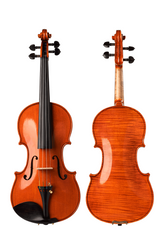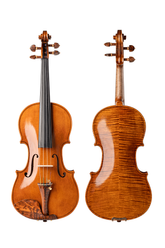How does your violin produce sound?
Do you know? The violin is an instrument that constantly imitates the human voice and develops and changes continuously. This is one of the reasons why the violin sounds so pleasant. So how does the violin work? What is the reason for its beautiful sound?
Material is the most basic factor
Each material has its unique acoustic properties. For example, the resonance of copper is very good, but the loudness is not as high as that of iron. Therefore, brass instruments cannot be made of iron. Otherwise, all we hear in the concert hall is screeching noise.
The same is true for violins. Now there are violins made of carbon fiber, but most violin lovers still prefer wooden violins. Regarding the wood of the violin, there have been many articles explaining it before. If you want to know more, you can check it at https://fiddlover.com/blogs/news.
Due to the influence of the growth environment and human factors, the wood of the violin will show different acoustic characteristics even if it is the same kind of wood. Therefore, the material is the basis for the sound of all violins. Only good materials can make high-end violins.
The unique structure is an important factor in the sound of the violin
In the Stradivari era, the structure of the violin was constantly developing and changing, but now the violin has formed a relatively stable structure. From the perspective of the founding principle of the violin, it is mainly divided into Excite Part, Vibrating Part, Resonance Part, and Conductor Part.
1: Excite Part
This part refers to the violin bow. The strings of a violin bow are made of horsetail hair and are attached to the ends of the shaft. Horsetail hair is the longest fibrous structure in nature. If you look at it with a magnifying glass, you will find that there are very sharp hook-shaped scales on the horsetail hair. This is the hair scale, and it is also a key factor for vibration. Before playing the violin, the strings need to be rubbed with rosin to increase their stickiness, so that they can be hooked to the strings through the hair scales. When the player pulls the bow, the constant friction between the strings and the bow produces friction. When the elastic energy of the strings is greater than the friction, the strings will rebound and eventually vibrate.
The amount of vibration depends on your play bowing skills, but also the material and shape of the shaft, the quality of the bow hair, and the rosin are also very important factors. So a good bow can do more with less, and if you need it, you can buy it through the Fiddlover Violin Shop.
2:Vibrating Part
The Vibrating Part of a violin is the strings. Strings can be divided into gut strings, nylon strings, and steel strings. Different strings have different characteristics. The original violin used gut strings, which are characterized by a soft and beautiful sound, which is closer to the human voice but is easy to break. In the 19th century, with the development of the metallurgical industry, steel strings were favored by people. This kind of string is stable and durable, but its elasticity is poor, and the sound is harsh and lacks a sense of hierarchy. So later, people developed in addition to nylon strings, these kinds of strings made of man-made fibers as cores. It combines the characteristics of gut strings and steel strings, that is, it is more durable than gut strings and has a better sound than steel strings. So it is loved by people. However, the three kinds of strings have their advantages, and they still need to be used according to the situation.
After the strings of the violin vibrate, they use the principle of standing waves to produce sound. It can be simply understood that the vibration is transmitted to both ends of the string at the vibration point, and then the two ends are transmitted back on the string, forming a standing wave on the string. All stringed instruments sound through this principle.
But if it is only the sound produced by the vibration of the strings, it is almost inaudible to the human ear, so the Resonance Part is needed to help the sound.
3: Resonance Part
This refers to the body of the violin. The resonance box is mainly composed of the top plate, back plate, and rib. Then the sound is transmitted through the F hole. For the resonance box, in addition to the structure, the most important thing is the material of each part. For example, it is better to use spruce with 1 grain per millimeter for the panel. It is best to use the same material for the side panel as the back panel, but since the side panel is very thin, you need to be careful when making it or it will break easily. The back panel is generally made of maple, which is very suitable in terms of acoustic performance and aesthetics.
After the vibration of the strings is amplified by the Resonance Part, the sound is finally transmitted through the F hole on the panel, which is the final sound of the violin we hear.
4: Conductor Part
The transmission of vibration between the strings and the body requires a conductor, which is the Conductor Part of the violin, which mainly includes the bridge, bass bar, and sound-post.
The bridge is the hub where the vibration of the strings is directly transmitted to the top plate. A properly engraved and assembled bridge can take the center as the axis and is very sensitive to transmit various vibrations to the panel at almost the same speed, thereby causing the top plate to vibrate. In the lower left part of the bridge, the corresponding position inside the panel is the bass bar. Its function is to assist the top plate to bear the pressure on the left side of the bridge, and to transmit the vibration generated by the bass strings to both ends of the top plate more sensitively, so that the G The sound of the two strings and D is more mellow. On the bottom right of the bridge, the sound-post are mounted between the top and back. It is also the hub for the vibration transmission of the top and back plates. Some people think that the violin fret is the heart of the violin, which shows that it is very important. Its main function is to transmit the vibration of the top plate to the back plate, and secondly, it can also share the pressure on the panel. After all, the top plate of the violin needs to bear about 11 kilograms of pressure.
The sounding process of the violin
On the whole, the violin generates vibration through the friction between the bow and the strings and then transmits it to the top plate through the bridge, and then the bass bar assists to spread to the entire plate, and then transmits it to the back plate through the sound-post, forming a resonance inside the box. Finally, the beautiful violin sound is transmitted through the F-holes.
Follow Fiddlover to learn more about the violin.






1 comment